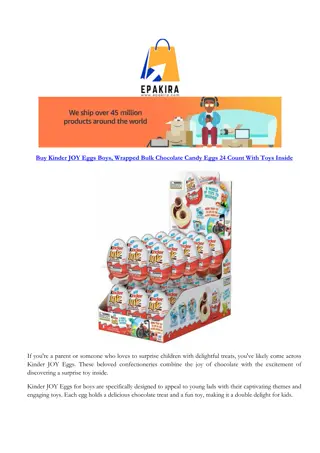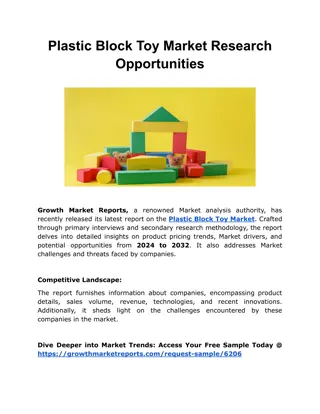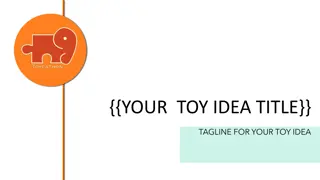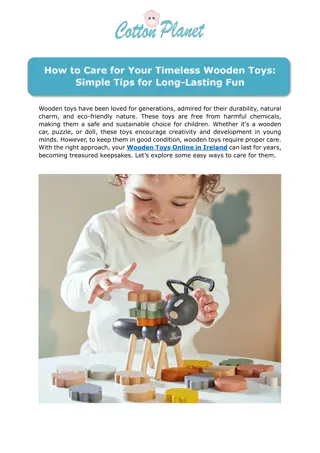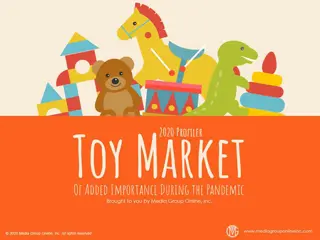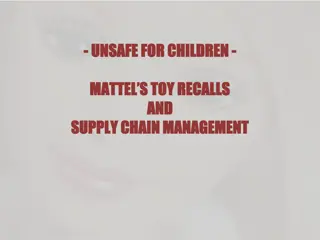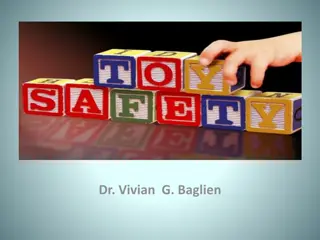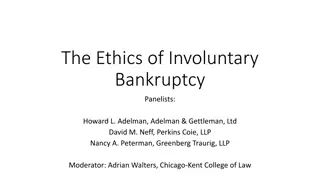Impact of Toys R Us Bankruptcy on Toy Industry Trends
The bankruptcy of Toys R Us has had a significant impact on the toy industry, with traditional toy sales decreasing and a shift towards digital entertainment. Major toy manufacturers like Hasbro and Mattel are adapting to changing trends and focusing on educational toys. The industry is evolving with new toy trends and a growing interest in games, hobbies, and crafts among children and Millennial parents.
Download Presentation

Please find below an Image/Link to download the presentation.
The content on the website is provided AS IS for your information and personal use only. It may not be sold, licensed, or shared on other websites without obtaining consent from the author.If you encounter any issues during the download, it is possible that the publisher has removed the file from their server.
You are allowed to download the files provided on this website for personal or commercial use, subject to the condition that they are used lawfully. All files are the property of their respective owners.
The content on the website is provided AS IS for your information and personal use only. It may not be sold, licensed, or shared on other websites without obtaining consent from the author.
E N D
Presentation Transcript
Still Working Through the Toys R Us Bankruptcy Few retail bankruptcies have had as much impact as the end of Toys R Us, which industry analysts claim was a major factor in a 2% decrease in total 2018 US toy sales, or $21.6 billion. At the physical-store level, the industry did even worse. (See Profiler.) Children s interest in and transition from traditional toys to entertainment on digital devices has been and continues to be another major factor negatively affecting the industry. According to IBISWorld, revenues will decrease 1.1% through 2024. The Toys R Us brand is making a comeback, albeit a small one. Tru Kids Brands, which owns the Toys R Us brand, and b8ta, which is primarily an electronics retailer, will open two stores (Houston and Paramus, NJ) for the 2019 holiday season.
More News from the Toy Aisle As the two largest toy manufacturers, Hasbro and Mattel, were particularly devastated when Toys R Us closed shop, but they seem to be recovering as their Q2 2019 net revenues increased 65% and 2%, respectively. Both companies may soon do even better. Mattel expects its live-action Barbie film to boost sales and Hasbro has similar projects related to its Transformer toys. They are also responding to today s children s tastes with more digital games. Educational toys is forecast to be a successful sub- category for the industry, as Market Study Report predicts a CAGR (compounded annual growth rate) of 5.2% for the category through 2024.
The Ever-Evolving Toy Trends The concept of experience, as it relates to unboxing a toy, was one of the emerging trends from the annual Toy Fair (January 2019). That is part of the fun of toys for children, so more manufacturers are focusing on the packaging as much as the toy. Education has always been an important toy sub- category, but more food-related toys and games will appear during 2019, as young parents, who have made healthy eating a major lifestyle component, want to promote this concept among their children. Some of the trending toys featured at the Toy Fair for Christmas 2019 included magnetic building tiles, traditional board games, play sets for smaller spaces, throwing (safe) objects (Nerf alternatives) and hedgehogs and sloths replacing unicorns and llamas.
More Children Adding Games, Hobbies and Crafts to Their Activities As a new generation of kids (and their Millennial parents) perceptions and play choices evolve, the games, hobbies and crafts market experienced a 500% increase from 2008 through 2017 while the traditional toy market was only increasing by 25%. Some of the major retail craft chains, Joann in particular, have recognized Millennials as the newest segment of crafters and are evolving their stores to reflect their interests, which is probably also influencing their children and attracting them to crafting. Michaels, another major craft chain, may have seen the memo, but finds itself ill prepared for this younger audience, as industry analysts have categorized its digital marketing and e-commerce efforts as well behind the curve and its competitors.
Major Shifts in Child Population and Ethnicity Toy manufacturers and retailers must be prepared for the significant changes in US children s population trends. One of the most significant is Caucasian American children younger than 15 are now less than half (49.9%) of all children in that age range. As of 2017, Latinx American children attending kindergarten were at least 20% of all kindergarten students in 18 states and the District of Columbia, compared to 8 states during 2000. By 2035, there will be more adults 65+, or 78.0 million/23.5%, than children younger than 18, or 76.4 million/19.8%. By 2060, the gap will increase to 94.7 million and 79.8 million, respectively.
Fewer Parents Is Why the Toy Market Will Continue to Shrink If there will be fewer children than seniors by 2035, that means fewer young adults will be parents. The current average age of marriage of approximately 30 (the highest ever), for both men and women, supports a future of fewer children and toy purchases. Parents, of course, aren t the only toy purchasers: there are many young adults who aren t married and are parents. Grandparents also buy toys for children in the family and with so many predicted to live longer, they are a prime target audience. An interesting comparison is single adults vs. married adults, younger than 35 and both groups without children. (See the data from The Media Audit s 2019 Rolling Aggregate Report of 66 US markets and representing more than 143 million US adults in the Profiler.)
Advertising Strategies For the 2019 holiday season and beyond, toy stores must increase their inventories of educational activities (STEM and STEAM) as well as digital-based toys, devices and accessories. Traditional toys are now just a sub-sector of a much bigger product category. A local toy store that aggressively features and promotes products in the new and growing category of food-related toys will send a very positive message to parents, which builds trust and loyal customers. You may discover an opportunity with games, hobbies and craft stores to encourage them to stock products that could appeal to children and, maybe more importantly, to attract the millions of Millennials who are crafting and who may pass the interest to their children.
New Media Strategies Toys can be marketed via digital media in a myriad of ways. Email campaigns are very effective. Update or create a mailing list of your customers (with an incentive) and send them a series of emails featuring specific toys throughout the holiday season. Some children have become major influencers on social media, especially YouTube. A toy store may be able to find one or more parents with an extroverted, expressive child who could star in a series of short videos demonstrating and critiquing new toys. As today s Baby Boomer grandparents live longer, they are a long-term target audience for toy stores. They are flocking to social media in large numbers and it is an excellent channel to share an online catalog and promote special online offers just for the 65+ set.


